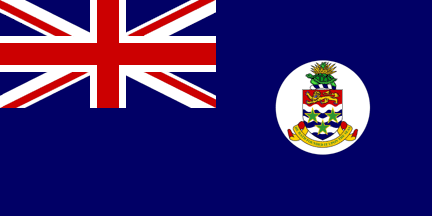 image by Clay Moss, 14 January 2010
image by Clay Moss, 14 January 2010
FOTW beschäftigt sich mit der Wissenschaft der Vexillologie (Flaggenkunde).
Alle auf dieser Website dargebotenen Abbildungen dienen ausschließlich der Informationsvermittlung im Sinne der Flaggenkunde.
Wir distanziert uns ausdrücklich von allen hierauf dargestellten Symbolen verfassungsfeindlicher Organisationen.
Last modified: 2022-05-14 by rob raeside
Keywords: cayman islands | lion | pineapple | turtle | star (green) | stars: 3 | ensign: blue | civil ensign |
Links: FOTW homepage |
search |
disclaimer and copyright |
write us |
mirrors
 image by Clay Moss, 14 January 2010
image by Clay Moss, 14 January 2010
See also:
 image by Graham Bartram
image by Graham Bartram
Adopted: 1999
Previous Ensign
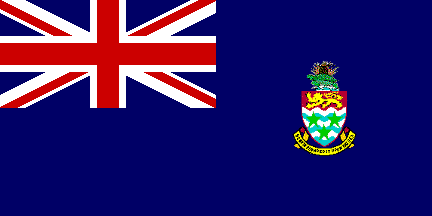 image by Željko Heimer and Antonio Martins,
19 June 2000
image by Željko Heimer and Antonio Martins,
19 June 2000
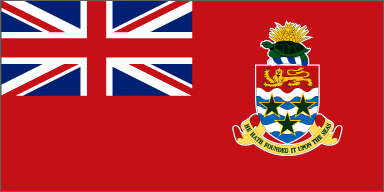 image by Graham Bartram
image by Graham Bartram
Adopted: 1999
Last summer I saw a boat, flying the Cayman Islands Red
Ensign while docked at a pier on Long Island.
Ned Smith, 10 September 2000
The shade of red used on official Union Jacks and derived
flags is "dark red" (aka "Post Office red").
The RGB equivalent would be RGB:204-0-0. The Pantone reference is
186
Antonio Martins and Graham Bartram, 13
September 2000
My entirely personal interpretation of the Merchant Shipping
(Registration,etc.) Act 1993, is that the undefaced British Red
Ensign is the primary ensign of a vessel registered in the Cayman
Islands, and the Cayman Islands Red Ensign is an authorised
option.
In schedule 3, para. 1, a British ship is defined as, a ship
registered in the United Kingdom under the Act, or a ship
registered under the law of a relevant British possession.
In schedule 3, para. 2 (1), the Act states that the flag which
every British ship is entitled to fly is the Red Ensign (without
any defacement or modification) except for;
3, para.2 (3), a. - colours allowed to be worn in pursuance of a
warrant from Her Majesty or from the Secretary of State.
b. - defaced or modified Red Ensigns authorised or confirmed by
Her majesty by Order in Council for wear by British ships
registered in a relevant British possession.
David Prothero, 21 May 2002
I have found that my answer of 21st May was partly
wrong. The British Red Ensign is again an alternative
ensign for Cayman registered ships, but between 1988 and sometime
in the late 1990s it technically was not.
Until 1993 merchant shipping of British possessions was regulated
by the 1894 Merchant Shipping Act, as amended. By the 1980s it
was becoming difficult to correlate amendments and
territories. This was a particular problem in the Cayman
Islands which had a more extensive register of shipping than
other dependent territories. In 1988 an Order in Council,
relevant only to the Cayman Islands, codified the 1894 Act
together with relevant modifications and amendments, and stated
that the Order in Council itself, and not the 1894 Act, was the
law of the Islands in relation to merchant shipping. This
included a statement that the Red Ensign defaced with the Cayman
Islands crest was the proper national colours for Cayman vessels.
Due to a drafting error, or through an oversight, no provision
was made for the plain Red Ensign. This was corrected by a
clause, inserted into an Order in Council of the late 1990s,
which modified the flag provision to include the plain Red Ensign
as well as the defaced Red Ensign.
David Prothero, 21 June 2002
Previous Civil Ensign (Still in Use)
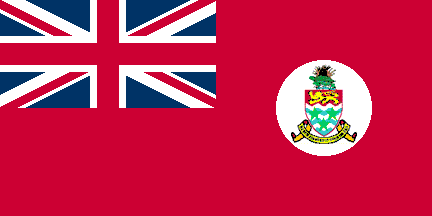 image by Željko Heimer and Antonio Martins,
5 January 2000
image by Željko Heimer and Antonio Martins,
5 January 2000
I have just seen a visiting ship in Bristol City Docks - the
'Intuition II' - with its port of registration in 'Georgetown
C.I.'. She is flying a defaced red ensign with the arms on a
white disc - and the flag doesn't look particularly old and
tattered, so I guess in practice the old design continues to be
made and used.
André Coutanche, 4 June 2003
The changing of the size of the badge and/or arms, with the
deletion of the white disk and addition of a fimbriation is
official only in so far such flags are illustrated like this in
the latest change in BR20 - Flags of All Nations - published by
the Ministry of Defence, and is (as far as I can tell) an
entirely arbitrary decision by them.
There are, as far as I remember, three (there could well be four
or more) defaced red ensigns defined by Schedule, of these one
shows a white disk, that of the Falkland Islands whilst two do
not, those of Gibraltar and of Guernsey. The remainder may
include the traditional white disk or not as the fancy takes
them.
Christopher Southworth, 4 June 2003
While visiting Stockholm for ICV 20, we noticed a huge yacht
and a sailing boat, both hoisting the Cayman Islands red ensign
with white disc. Here is a photo.
Marcus Schmöger, 6 August 2003
The use of the red ensign defaced by the national crest,
accompanying an article about ship registration in the 2002
Professional Yachtsmen's Association PYA News has triggered a
response in this year's edition from Peter Gibbs, the Director of
the Cayman Islands Shipping Registry. He points the finger
at an amendment to the Royal Navy's one time bible of flag
descriptions, which was apparently riddled with errors. To
extract from his article: "All these changes were done
without any consultation with the Cayman Islands. The
reasoning for removing the white disc was that no such disc had
been prescribed in the original warrant. The relative size
of the coat of arms was changed so as to achieve uniformity
between the flags. Although these arguments may at first
appear to be plausible, on closer examination they prove to be
specious.
If we look to the description of our coat of arms, set out in the
Royal Warrant issued by the College of Arms in 1958, we find that
it neither mandates nor precludes the white disc. However,
customary practice is something very important in the development
of flag tradition. The use of a white disc in the
background has been customary practice in British territories at
least since 1869 and has been common to virtually all Union Flag
defacements. The Cayman Islands chose to represent their
national coat of arms similarly, and this has been the customary
practice since the flag's inception.
The Royal Warrant makes no reference to the relative size of the
coat of arms on the flag and no reference to uniformity between
the flags of different British territories. Taking the
proponent's two arguments together, it seems that the absence of
any specific reference to a white disc was used as a reason for
removing it, yet, at the same time, the absence of any specific
reference to relative size of the coat of arms underpinned the
argument for imposing a change!"
Simon Jackson, 20 October 2003
While I sympathise with the view that changes to the Cayman
Islands' flags, as shown in an official book, should not have
been made without consultation, it is incorrect to say that,
"The use of a white disc in the background has been
customary practice in British territories at least since 1869
..."
Most of the early colonial flag badges were circular, and the
question of a white disc did not arise. When the badge was
not circular, a white (or sometimes coloured) disc was necessary
on the Governor's Union Jack, to fill the space between the edges
of the badge and the laurel leaf garland. On ensigns, there
was no space to fill and non-circular badges should have been
placed on the fly with no disc. However in some cases the
badge was given a white background disc, either because there was
one on the governor's flag and it was thought that the ensign
should be the same, or because drawings of badges in the
Admiralty and Colonial Office Flag Books were framed within a
black ring, and it was thought that the white circle within the
ring was part of the badge.
In 1916 a note at the beginning of the Admiralty Flag Books
reads; "White circles are generally to appear on the Union
Flag except where otherwise noted beneath the design. The
white circles are not to appear on the Red and Blue Ensigns
except where they are necessary to display the design; e.g. where
the badge itself has a border of the same colour as the
ensign."
In a Colonial Office minute of 1918 it was noted that,
"..there are occasions for a diversity of opinion, where the
border of a badge is not uniform.", and in 1919 the Colonial
Office circulated a questionnaire to all colonial governors and
administrators asking whether the flag badge of the colony or
territory appeared on a white disc. By 1924, after
consultation with the governors concerned, white discs had been
removed from the ensigns of nine colonies. Details in
National Archives (PRO) ADM 116/1847B.
During this period Red Ensigns were introduced for thirteen
Indian States with the note; "Unless there is some special
reason for obtaining a particular colour around the badge, the
badge should appear on the Red Ensign without a surrounding
circular disc except that if the colouring of the badge is
indistinguishable from the red field the badge shall appear in a
white circle."
David Prothero, 20 October 2003
Is the flag with a white disk acceptable?
The definitive answer to this would depend upon whether the Order
in Council (of 1988) that established it included a schedule with
illustration, and whether this schedule (if present) showed the
white disk?
I am (in addition) not entirely sure whether the 1985 Merchant
Shipping Act contained the same provisions as that of 1995
regarding such ensigns, but it is certain that no defaced Red
Ensign established by Royal Order in Council after 1995 (and all
the ones in my possession contain a schedule as described) can be
amended by an arbitrary decision of civil servants to add or
delete anything. The short answer is that the ensign
with a white disk is probably (but not certainly) the correct
flag, and is (in anycase) acceptable. Ships registered in
the Cayman Island have the option (the priviledge if you prefer)
of flying an ensign defaced with the Cayman Islands Arms, but it
is not mandatory that they should do so. The plain Red
Ensign remains a perfectly legal option for all British Dependent
Territories.
Christopher Southworth, 14 October 2004
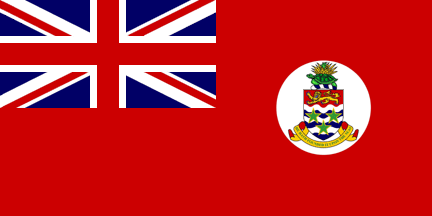 image by Clay Moss, 14 January 2010
image by Clay Moss, 14 January 2010
 image by Clay Moss, 14 January 2010
image by Clay Moss, 14 January 2010
I just received a nice old Cayman Islands blue ensign from a
friend that was recently there. It is a Porter Brothers piece and
according to the heading, was made in September, 1960. I found it
interesting in that the wavy stripes on the shield are dark blue
and the pine apple has a bit of green flora above it. This is not
the first such Caymans badge I have seen and I believe this these
images represent how the badge initially looked, at least on
actual flags.
Clay Moss, 14 January 2010
Foreign civilian ships visiting any British Overseas Territory
should fly, as a courtesy flag, the Territory's own Red Ensign,
if the territory has one and the ship happens to carry one. The
undefaced British Red Ensign is always an acceptable alternative.
If the ship is a Foreign government vessel they should fly the
Territory's Blue Ensign.
Basically the British rule is that you may use either the
appropriate Red, Blue or White ensign (depending upon your own
status) or the land flag, except that you cannot use the Union
Flag at all.
Graham Bartram, 1 April 1999
Hosted by: Fanshop-Online.de und Handy-Shop.de
Tipp: Apple iPhone 13 im Shop